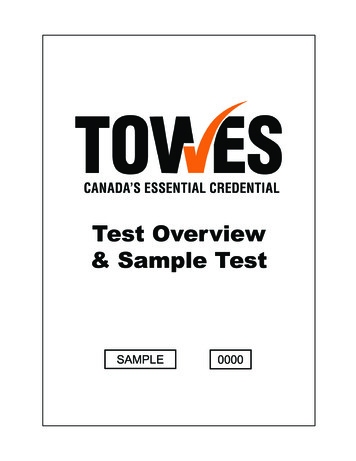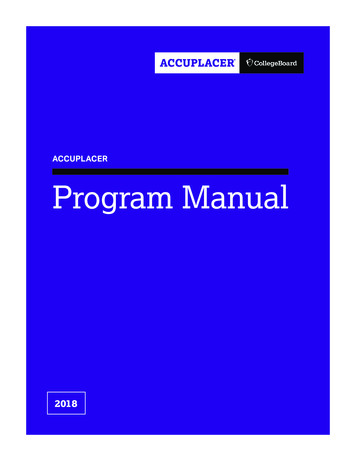
Transcription
Informationfor CandidatesIntroducing IELTSto test takersielts.org
The test thatopens doorsaround the worldThis booklet containsimportant informationto help you preparefor your IELTS test.IELTS, the International EnglishLanguage Testing System, isdesigned to assess the languageability of people who want tostudy or work where English isthe language of communication.IELTS is recognised and accepted byover 10,000 organisations worldwide,including universities, employers,professional bodies, immigrationauthorities and other governmentagencies. For a list of organisationsthat accept IELTS scores,visit ielts.org/recognition.Accessible and convenientIELTS is offered up to four times a month in more than140 countries. Tests are held on Saturdays and Thursdays.To find out test dates in your area, please contact yournearest IELTS test centre. A list of all IELTS test locationsworldwide is available at ielts.org.The international testIELTS is internationally focused in its content. For example,texts and tasks are sourced from publications from all overthe English-speaking world; a range of native-speaker accents(North American, Australian, New Zealand, British etc.) areused in the Listening test; and all standard varieties of Englishare accepted in test takers’ written and spoken responses.The test that’s tried and trustedIELTS has been developed by some of the world’s leadingexperts in language assessment, and is supported byan extensive programme of research, validation andtest development.The level of the testIELTS is designed to assess English language skills acrossa wide range of levels. There is no such thing as a pass orfail in IELTS. Results are reported as band scores on a scalefrom 1 (the lowest) to 9 (the highest).The IELTS band score scale9Expert user8Very good user7Good user6Competent user5Modest user4Limited user3Extremely limited user2Intermittent user1Non user0Did not attempt the testIELTS for UK Visas and ImmigrationFind out how you can use an IELTS result forthis purpose at ielts.org/unitedkingdom.For more information on going to or staying in theUK, visit gov.uk.
Preparing for your testTest formatMake sure you are ready to demonstrate your English1. Familiarise yourself with the format of the test by reading thisbooklet. If you would like more information about the formatof the test and the question types used, you can find the testspecifications at ielts.org/testformat.There are two modules to choose from –Academic and General Training.2. Practice using sample questions from ielts.org/sampletest.3. Consider doing a practice test. Two volumes of Official IELTSPractice Materials are available for purchase from test centres orat ielts.org/prepare. These materials include a full practice testwith answers, and sample Writing and Speaking performanceswith examiner comments.4. Consider enrolling in a preparation course to improve yourperformance in the test. IELTS test centres and languageschools around the world offer IELTS preparation courses.More information is available .org/usaKnow the IELTS rules and regulationsIt’s important to familiarise yourself with the IELTS rules andregulations. These are laid out in the Notice to Candidatesand Declaration which are included in the application form.When you sign the application form declaration, or agree tothe terms online, you are confirming that you have read andunderstood the IELTS rules and regulations and agree toabide by them.IELTS AcademicIELTS Academic is for test takers wishing to study atundergraduate or postgraduate levels, and for thoseseeking professional registration.IELTS General TrainingIELTS General Training is for test takers wishing to migrate to anEnglish-speaking country (Australia, Canada, New Zealand, UK),and for those wishing to train or study at below degree level.Each organisation sets its own entry requirements. In some casesboth Academic or General Training may be accepted. If you arein doubt as to which to take, you should contact the organisationyou are applying to in order to check their requirements.You are tested on all four language skills – listening, reading,writing and speaking, unless you have an exemption due toa disability (see section on special requirements). Everyonetakes the same Listening and Speaking tests. There aredifferent Reading and Writing tests for IELTS Academic andGeneral Training.The Listening, Reading and Writing tests must be completedon the same day. The order in which these tests are takenmay vary. There are no breaks between these three tests.The Speaking test may be taken up to seven days beforeor after the other three tests.Register as soon as possibleWhen you feel you are ready to take the test, you need toregister for a test date with an IELTS centre. Contact thecentre as soon as possible, as the number of test takerswho can take the test on a particular date may be limited.You will need to pay the test fee when you register.Tell your centre if you have special requirementsIn order to ensure that the language ability of all test takersis assessed fairly and objectively, IELTS provides acomprehensive service for test takers who have specialrequirements, including specific learning difficulties, hearingdifficulties, visual difficulties, medical conditions or infant feeding.If you require a modified version of the test, for example a LargePrint or Braille version, you must give the test centre threemonths’ notice. This notice period is necessary for the modifiedtest version to be prepared. If your circumstances require specialadministrative arrangements to be made, for example if you needextra time or you need to use access technology such as a screenreader, you must give the test centre six weeks’ notice. Pleasecontact your test centre to discuss your requirements. Any specialarrangements agreed are in accordance with the Joint Councilfor Qualifications (JCQ).ListeningAcademic ReadingGeneral Training ReadingAcademic WritingGeneral Training WritingSpeaking3
The four components of the IELTS testListeningTimingApproximately 30 minutes (plus 10 minutes’ transfer time).QuestionsThere are 40 questions. A variety of question types are used,chosen from the following: multiple choice, matching, plan/map/diagram labelling, form completion, note completion,table completion, flow-chart completion, summary completion,sentence completion, short-answer questions.Test Parts There are 4 sections: Section1 is a conversation between two people setin an everyday social context (e.g. a conversation inan accommodation agency).Section 2 is a monologue set in an everyday social context(e.g. a speech about local facilities or a talk about thearrangements for meals during a conference).Section 3 is a conversation between up to four peopleset in an educational or training context (e.g. a universitytutor and a student discussing an assignment, or a groupof students planning a research project).Section 4 is a monologue on an academic subject(e.g. a university lecture).Each section is heard once only.A variety of voices and native-speaker accents are used.Skills assessedA wide range of listening skills are assessed, including: understanding of main ideas understanding of specific factual information recognising opinions, attitudes and purpose of a speaker following the development of an argument.MarkingEach correct answer receives 1 mark. Scores outof 40 are converted to the IELTS 9-band scale.Scores are reported in whole and half bands.ReadingTiming60 minutes (no extra transfer time).QuestionsThere are 40 questions. A variety of question types areused, chosen from the following: multiple choice, identifyinginformation (True/False/Not Given), identifying a writer’sviews/claims (Yes/No/Not Given), matching information,matching headings, matching features, matching sentenceendings, sentence completion, summary completion,note completion, table completion, flow-chart completion,diagram label completion, short-answer questions.Test PartsThere are 3 sections. The total text length is 2,150-2,750 words.Academic ReadingEach section contains one long text. Texts are authentic andare taken from books, journals, magazines and newspapers.They have been written for a non-specialist audience and areon academic topics of general interest. Texts are appropriateto, and accessible to, test takers entering undergraduate orpostgraduate courses or seeking professional registration.Texts range from the descriptive and factual to the discursiveand analytical. Texts may contain non-verbal materials suchas diagrams, graphs or illustrations. If texts contain technicalterms, then a simple glossary is provided.General Training ReadingSection 1 contains two or three short factual texts, one of whichmay be composite (consisting of 6-8 short texts related by topic,e.g. hotel advertisements). Topics are relevant to everyday lifein an English-speaking country.Section 2 contains two short factual texts focusing on workrelated issues (e.g. applying for jobs, company policies, pay andconditions, workplace facilities, staff development and training).Section 3 contains one longer, more complex text on a topicof general interest.Texts are authentic and are taken from notices, advertisements,company handbooks, official documents, books, magazinesand newspapers.Skills assessedA wide range of reading skills are assessed, including: reading for gist reading for main ideas reading for detail understanding inferences and implied meaning recognising writer’s opinions, attitudes and purpose following the development of an argument.MarkingEach correct answer receives 1 mark. Scores outof 40 are converted to the IELTS 9-band scale.Scores are reported in whole and half bands.For test specifications visit ielts.org/testformatFor marking information visit ielts.org/criteriaFor sample questions visit ielts.org/sampletestIELTS for UK Visas and ImmigrationFind out how you can use an IELTS result for this purposeat ielts.org/unitedkingdom. For more information on goingto or staying in the UK, visit gov.uk.
WritingTiming60 minutesTasksThere are 2 tasks. You are required to write at least150 words for Task 1 and at least 250 words for Task 2.Test PartsThere are 2 parts.Academic WritingIn Task 1, you are presented with a graph, table, chart ordiagram and are asked to describe, summarise or explainthe information in your own words. You may be asked todescribe and explain data, describe the stages of a process,how something works or describe an object or event.In Task 2, you are asked to write an essay in responseto a point of view, argument or problem.The issues raised are of general interest to, suitable forand easily understood by test takers entering undergraduateor postgraduate studies or seeking professional registration.Responses to Task 1 and Task 2 should be writtenin an academic, semi-formal/neutral style.General Training WritingIn Task 1, you are presented with a situation and are asked towrite a letter requesting information or explaining the situation.The letter may be personal or semi-formal/neutral in style.In Task 2, you are asked to write an essay in response to apoint of view, argument or problem. The essay can be slightlymore personal in style than the Academic Writing Task 2 essay.Topics are of general interest.Skills assessedIn both tasks, you are assessed on your ability towrite a response which is appropriate in terms of: content the organisation of ideas the accuracy and range of vocabulary and grammar.Academic WritingIn Task 1, depending on the task type, you are assessed on yourability to organise, present and possibly compare data; to describethe stages of a process or procedure; to describe an object orevent or sequence of events; to explain how something works.In Task 2, depending on the task type, you are assessed onyour ability to present a solution to a problem; to present andjustify an opinion; to compare and contrast evidence, opinionsand implications; to evaluate and challenge ideas, evidenceor an argument.General Training WritingIn Task 1, depending on the task type, you are assessed on yourability to engage in personal correspondence in order to: elicitand provide general factual information; express needs, wants,likes and dislikes; express opinions (views, complaints etc.).In Task 2, you are assessed on your ability to provide generalfactual information; to outline a problem and present a solution;to present and possibly justify an opinion; to evaluate andchallenge ideas, evidence or an argument.MarkingYou are assessed on your performance on each taskby certificated IELTS examiners according to the IELTSWriting test assessment criteria (Task Achievement/Response,Coherence and Cohesion, Lexical Resource, GrammaticalRange and Accuracy). The public version of the assessmentcriteria can be found at ielts.org/criteria.Task 2 contributes twice as much as Task 1 to the Writing score.Scores are reported in whole and half bands.SpeakingTiming11-14 minutesTest PartsThere are 3 parts.Part 1 Introduction and interview (4-5 minutes)The examiner introduces him/herself and asks you to introduceyourself and confirm your identity. The examiner asks yougeneral questions on familiar topics, e.g. home, family, work,studies and interests.Part 2 Individual long turn (3-4 minutes)The examiner gives you a task card which asks you to talk abouta particular topic and which includes points you can cover in yourtalk. You are given 1 minute to prepare your talk, and are givena pencil and paper to make notes. You talk for 1-2 minutes onthe topic. The examiner may then ask you one or two questionson the same topic.Part 3 Two-way discussion (4-5 minutes)The examiner asks further questions which are connectedto the topic of Part 2. These questions give you an opportunityto discuss more abstract issues and ideas.Skills assessedA wide range of speaking skills are assessed, including: the ability to communicate opinions and informationon everyday topics and common experiences andsituations by answering a range of questions the ability to speak at length on a given topic usingappropriate language and organising ideas coherently the ability to express and justify opinions and to analyse,discuss and speculate about issues.MarkingYou are assessed on your performance throughout thetest by certificated IELTS examiners according to the IELTSSpeaking test assessment criteria (Fluency and Coherence,Lexical Resource, Grammatical Range and Accuracy,Pronunciation). The public version of the assessment criteriacan be found at ielts.org/criteria.Scores are reported in whole and half bands.5
Test tipsListening Each recording in the Listening test is heard once only. You will be given time to read through the questions beforeyou listen. As you listen, write your answers on the question paper.At the end of the test, you will have 10 minutes to transferyour answers to the answer sheet. It is essential that youtransfer your answers to the answer sheet as nothing youwrite on the question paper will be marked. You must write your answers in pencil. An example of a completed Listening answer sheetis given on the next page. ‘Completion’ question types (e.g. note completion):– Pay attention to the word limit. For example, if you areasked to complete a sentence using NO MORE THANTWO WORDS, and the correct answer is ‘leather coat’,the answer ‘coat made of leather’ would be incorrect.– Transfer only the missing word(s) to the answer sheet.For example, if you have to complete the note ‘in the ’,and the correct answer is ‘morning’, the answer ‘in the morning’would be incorrect.– You will hear the word(s) you need to use in the recording.You will not need to change the form of the word(s) you hear.– Pay attention to spelling and grammar: you will losemarks for mistakes.– You may write your answers in lower case or in capitals.Reading You may write your answers directly on the answer sheetor you may write them on the question paper and transferthem to the answer sheet before the end of the test. You willnot be given extra time to transfer answers at the end of thetest. Nothing you write on the question paper will be marked. You must write your answers in pencil. An example of a completed Reading answer sheet is givenon the next page. ‘Completion’ question types (e.g. note completion):– The same rules apply to ‘completion’ question typesas in Listening (see above).– The word(s) you use must be taken from the Reading text.You will not need to change the form of the word(s) in the text.Writing You may write your answers in pencil or pen. Pay attention to the number of words required for eachtask. You will lose marks if you do not write at least150 words for Task 1 and at least 250 words for Task 2. You should spend approximately 20 minutes on Task 1and approximately 40 minutes on Task 2. You must write your answers in full; answers writtenin note form or in bullet points will lose marks. Pay attention to spelling, grammar and punctuation;you will lose marks for mistakes. You may write your answers entirely in capitals if you wish. You may make notes on the question paper but nothing youwrite on the question paper will be marked.Test resultsThe Test Report FormYou will receive a Test Report Form which reports a score foreach of the four skills (listening, reading, writing and speaking),as well as an overall band score. Half band scores may beawarded to indicate a strong performance within a particularband. You can find more information on score processingand score interpretation at ielts.org/criteria.Results will be available 13 days after the test. At some testcentres test takers can collect their results on the 13th day. Atother test centres results are mailed to test takers on the 13th day.Test centres are not permitted to give results out over the phoneor by scan or email.You will receiveonly one copy of theTest Report Form.It’s important thatyou keep it safeas replacementTest Report Formscannot be issued.Test centres will sendcopies of your TestReport Form to up tofive organisations freeof charge.6Preview your results onlineYou can preview your results online 13 days after the test.Results remain online for 28 days. Please note that the onlinepreview of results should not be used as an official confirmationof your performance.Results validity periodOrganisations will not usually accept a Test Report Form thatis more than two years old unless you provide evidence thatyou have actively maintained or tried to improve your Englishsince taking the test. The IELTS Test Partners cannot confirmthe validity of test results that are more than two years old.Re-taking IELTSThere are no restrictions on re-taking IELTS. You can registerfor a test as soon as you feel you are ready to do so. Pleasenote that your score is unlikely to increase unless you makea significant effort to improve your English before re-taking thetest. More information is available from ielts.org/resitting.Enquiries on resultsIf you are unhappy with your test result, you can apply for are-mark (Enquiry on Results) at the centre where you tookthe test. You must make the application no later than six weeksafter the test date. You can choose which test componentsare re-marked. There is a fee for this service which will berefunded if your score on any component is increased.Enquiries on Results take six to eight weeks to complete.IELTS for UK Visas and ImmigrationFind out how you can use an IELTS result for this purposeat ielts.org/unitedkingdom. For more information on goingto or staying in the UK, visit gov.uk.
Do not writeanything in the / columnsIf you wantto change ananswer, eraseor cross out theoriginal answerand write in thenew answerWrite youranswers inthe boxesShade the boxesto indicate thetest dateWrite your namein capital lettersWrite your candidate number in the boxesindicated and shade the corresponding boxesPencil must be used to complete the answer sheetShade a box toindicate which versionyou are takingShade a box toindicate your genderWrite yourcandidate numberWrite your namein capital lettersWrite your language code in the boxes indicated andshade the corresponding boxes. (Your languagecode will be written on your desk label)Completing the Listening/Reading answer sheets7
IELTS five steps to success1Enquiry4Contact details for all IELTS test centres worldwidecan be found at ielts.org, where you can alsodownload the application form.2Your identity will be checked on the day of the testand before the Speaking test. You must present thesame identity document that you used when youregistered for the test. Your photograph will be takenas an additional security measure, and it will appearon your IELTS Test Report Form. In addition a fingerscan may be taken.RegistrationRead through all the information you receive withthe application form carefully. Complete the paperapplication form or online registration and submit itto your nearest test centre. You will need to enclosethe test fee or make the payment online.Make sure you enter the number of your identitydocument (your passport or national identity card)and attach a clear colour photocopy or scannedcopy of your identity document to the applicationform. The identity document must be valid at thetime of registration and the same ID documentmust be presented on the day of the test.3ConfirmationTest day5ResultsResults will be available 13 days after the test. Atsome test centres test takers can collect their resultson the 13th day. At other test centres results aremailed to test takers on the 13th day. Test centresare not permitted to give results out over the phoneor by scan or email.A preview of your results is available online 13 daysafter the test. Results will remain online for 28 days.Please note that the online preview of your resultsshould not be used as an official confirmation ofyour performance.The test centre will give you written confirmation ofthe date and time of the test. Your Speaking test timewill be scheduled on the same day as the written testsor on a different day within a 7-day window beforeor after the written tests. The test centre will confirmyour Speaking test time.Find out more at ielts.orgJoin the conversation atfacebook.com/IELTSofficialIELTS for UK, Australian, Canadian andNew Zealand visas and immigrationFind out how you can use an IELTS resultfor these purposes .org/canadaWatch our videos r privacyThe IELTS Test Partners recognise and support the right of genuine IELTS test candidates to privacy.For more information visit ielts.org/privacy.British CouncilBridgewater House58 Whitworth StreetManchester, M1 6BBUnited KingdomTel: 44 161 957 7755ielts@britishcouncil.orgIDP: IELTS AustraliaLevel 8, 535 Bourke StMelbourne VIC 3000AustraliaTel: 61 3 9612 4400ielts@idp.comCambridge AssessmentEnglishThe Triangle BuildingShaftesbury RoadCambridge, CB2 8EAUnited Kingdomcambridgeenglish.org/helpdeskIELTS USA825 Colorado BoulevardSuite 221Los Angeles, CA 90041USATel: 1 323 255 2771ielts@ieltsusa.orgIELTS is jointly owned by the British Council, IDP: IELTS Australia and Cambridge Assessment English. The IELTS test is designed and set by the world’s leading experts in language assessment to givea true picture of a test taker’s language skills. IELTS Bands 4-9 (NQF levels Entry 3 to Level 3) are accredited by Ofqual, England’s Office of Qualifications and Examinations Regulation.*7769635465*Copyright UCLES 2019 CER/6050/V2a/MAR2019
different Reading and Writing tests for IELTS Academic and General Training. The Listening, Reading and Writing tests must be completed on the same day. The order in which these tests are taken may vary. There are no breaks between these three tests. The Speaking test may be taken up to seven days before or after the other three tests.
